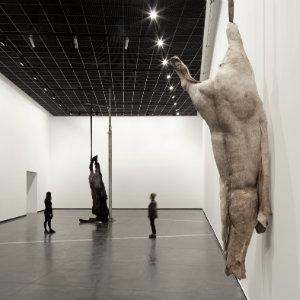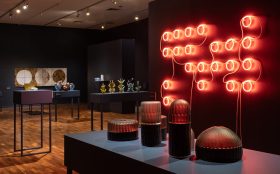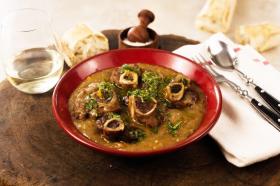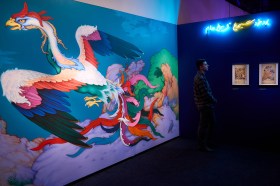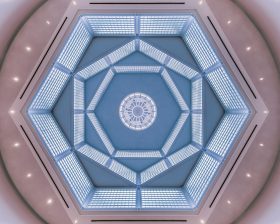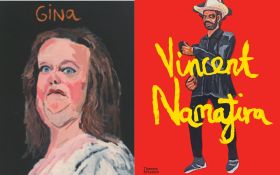Displayed alongside some of de Bruyckere’s notable works in We Are All Flesh at the Australian Centre for Contemporary Art (ACCA) are two new works, commissioned especially for this exhibition.
Approaching the main gallery space at ACCA, with its cathedral-like high ceilings and brightly lit white walls, the sight within is jolting. Hanging heavily on thick straps from a tall, rusted light pole and a jutting metal pole in the wall are two ambiguous, amorphous figures. Closer inspection reveals, in vivid detail, two horse hides sewn so as to be entwined (pictured, left).
Strolling the length of the main space, viewers have a mesmerised quality about their stance; hands deep in pockets, expressions shifting between concentrated frown and awe, getting as proximal as they dare to these still, grand figures which are simultaneously repulsive and seductive. Pausing reverently in their presence we feel deeply what the titles of these pieces, and the exhibition – We Are All Flesh – insinuate: that we are all connected elementally as living tissue, which will one day decay, and die.
The works physically embody what Francis Bacon strove to encapsulate in his insatiable exploration of the human condition, such as his paintings of metamorphic states between animal and human. Their crucifix-like hanging reflects the Christian symbolism frequently featured in Bacon’s work, and clearly draws from de Bruyckere’s Flemish roots.
Standing stoically in the centre of the rear gallery space is ‘019’. This grand museum-style cabinet contains an assortment of tree trunks coated thickly in wax; in the shelf underneath are piles of carefully folded blankets. The doors are swung open, inviting the slightly addled mind of the viewer a very welcome moment of repose or even a flight of fancy, as they ease their eyes over this quaint, contained forest.
In the assortment of pieces in this exhibition, a certain warmth and familiarity exudes from the wax, wood, horse hides, antlers, pillows, and other media. De Bruyckere masterfully manipulates these material forms, skewing their reality. Antlers and long sticks become unnervingly vein-like when coated in translucent, painted wax. In the piece entitled ‘Pillow’, where a human form plunges its unseen head into a plump pillow, the cast wax is so visceral it could easily be mistaken for pallid skin addled with angry red veins; only a double take and closer inspection allows one to concede that it is, indeed, only wax.
Berlinde de Bruyckere’s heavily symbolic sculptures elicit strong emotional and physical reactions, teasing out issues we do not normally feel comfortable contemplating. It is a demanding exhibition to view, but well worth visiting, just to explore the darker themes of the self that our minds regularly close off in the humdrum of our everyday lives. We are All Flesh is an exhibition to approach slowly, with sensitivity and open eyes. Like a well worn, dog eared book, these pieces unfold slowly, with patience and time.
Rating: 4.5 stars out of 5
We Are All Flesh
By Berlinde de Bruyckere
Curated by Juliana Engberg
Australian Centre for Contemporary Art, Melbourne
June 2 – July 29
